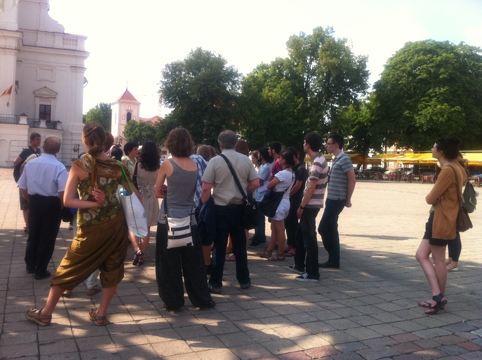July 26
When I walked into the room at Vytautus Magnus University to take the summer course language test, I was handed two pieces of paper and told to sit anywhere at the large conference table. Others were already bent over their tests.
I looked at the papers I was handed, and began to sweat. One was an illustration of a family packing for vacation. The other contained several exercises, the instructions for which were all written in Lithuanian. I couldn’t really understand any of the instructions, but I was bound and determined not to end up in the beginner group. I didn’t want to waste my time relearning the grammar system and basic conversations. I would just have to exercise logic and guess at what they wanted.
I recognized the word paveikslas (picture or painting) in the first exercise, plus a form of the verb rašyti, to write. There were 10 blank lines under the instruction, so I guessed that they wanted us to describe what was going on in the illustration. My vocabulary is very limited, and I certainly didn’t know the words for many of the items pictured: a badminton shuttlecock, a fishing pole, a stuffed animal, a raquet, a blow-up ducky inner tube. I didn’t even know the words for packing, wearing, carrying or holding. Or vacation.
I resorted to first-grade sentences: There is a bird. There is a dog. There is a house. The man has a hat. (Has, has… wait, does the verb to have take accusative or genitive? What is the accusative ending for a feminine singular noun in the second declension? Crap, I should have this memorized by now.) The boy also has a hat. The woman has a dress with flowers. The woman has a purse. The girl is on the grass. The cat is in the car. The grandmother is in the window. The family is going to the sea and is happy. (Okay, that last one wasn’t actually illustrated so much as inferred, but I had to somehow demonstrate that I could put more than three words together.)
I got a bit of a break after that, because the next exercise was to conjugate two verbs in just the first person. Verbs I can do, most of the time. The present, past, future and past frequentive for the irregular verb būti, to be: aš esu (I am), aš buvau (I was), aš būsiu (I will be), as būdavau (I used to be). Now valgyti, to eat: aš valgau, valgiau, valgysiu, valgydavau.
Next exercise: a list of words at the top, and an equal number of sentences with blanks. I know a fill-in-the blank when I see one, but I had two problems. The first was that I have a limited vocabulary in Lithuanian and only recognized the root forms for about half of the words listed. The second problem was that I still cannot remember which endings go with which seven parts of speech in each of the five noun declensions. It’s essential to know them for sentences to make sense, especially as the ending of the word takes the place of a preposition in some instances, and sometimes the same ending indicates a different part of speech depending on whether the word is masculine or feminine and in which declension it is. For example, vyrai is nominative plural of the masculine noun vyras. But rankai is dative singular for the feminine noun ranka. I knew I’d be relying on logic and the process of elimination. If the sentence mentioned driving and a ticket, it must be the word that has bus as the root. I think I got about half right.
The final exercise consisted of 10 sentences each in a two-column grid, one column numbered and the other one preceded by letters. I finally got that the numbers across the bottom of the page with blanks under them meant that they were looking to match the statement in the first column with the correct response in the second. After matching “Merry Christmas” with “You, too” and a few other simple questions and answers concerning names, addresses and dorm room numbers, I had to again rely on logic and the process of elimination for the rest, but think I got them all.
After handing in the test, I joined the other students in the waiting area. Once the written tests are graded, you go back one by one for a short conversation to determine comprehension and conversational skill. Then they decide in which class you belong.
When I went back in, I was asked my name, and the teachers shuffled through the pile of papers to find my test. They looked it over and then asked in Lithuanian where I was from and why I wanted to learn the language. I answered in Lithuanian, telling them that I was studying in Philadelphia, that my teacher was from Kaunas and that all of my grandparents came from Lithuania. They looked a bit surprised, then pleased. We had a bit more small talk: what was my teacher’s name, from where in Lithuania did my grandparents come. Then they conferred.
Much to my surprise, I was given the choice to join either the advanced or intermediate group. They encouraged me to start in the advanced class, repeating, “But you speak…” I kept saying, “But not well… And my grammar is bad… And my vocabulary is small…” We agreed that I could start out in the intermediate class, but if either the teacher or I thought it was too easy, I could transfer to the advanced class before the end of the week.
I walked to lunch with a couple of other students, comparing notes on where we placed, and if we were happy. I was. Once I got back to the dorm, though, I couldn’t do much more than take a nap.

